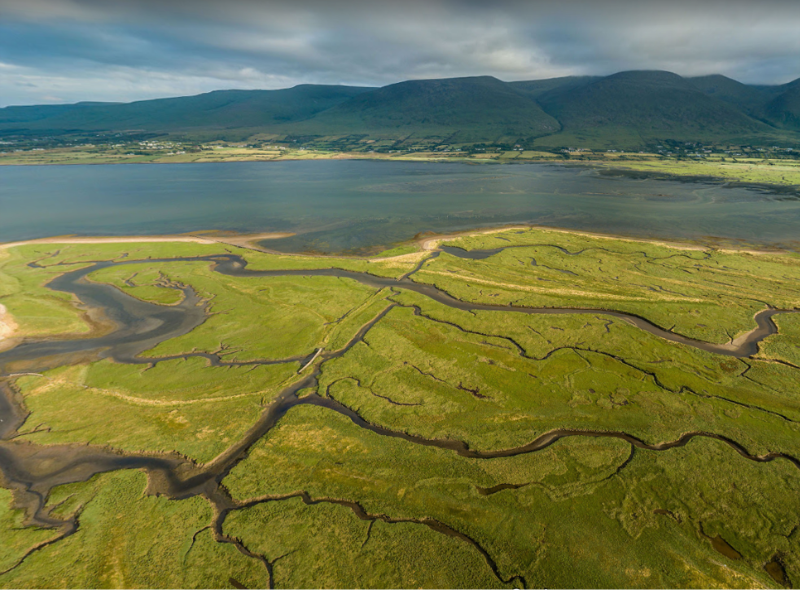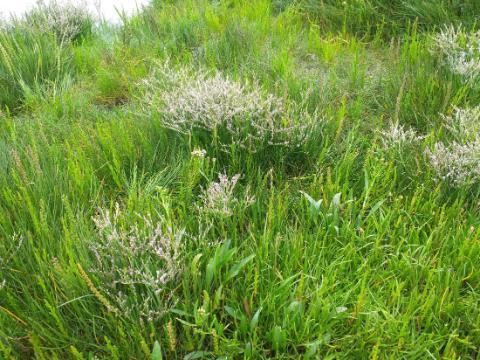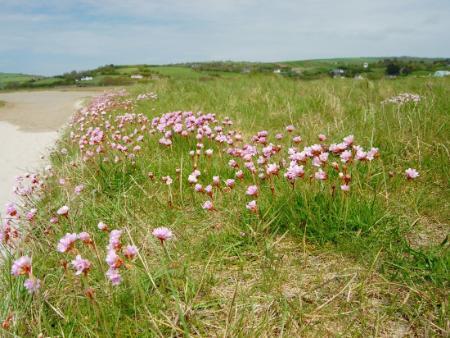Saltmarshes - Much More Than Meets the Eye
Friday, 27 September, 2024
Sitting unassumingly on the margins of our coasts, between tide and terrestrial, lie saltmarsh habitats. These habitats, long perceived as waste grounds and areas for land reclamation, are in fact a major ally in mitigating and adapting to climate change says (opens in a new window)Dr Grace Cott (UCD School of Biology and Environmental Science).
Sediments, seeds and energy

Derrymore Saltmarsh, Co Kerry.
Saltmarshes usually form along coasts where there is low wave energy, such as in estuaries, in the lee of sand spits, or on sheltered coastal plains. They consist of dense stands of plants that can tolerate the salty conditions.
There are four main elements necessary for the development and growth of a saltmarsh. Firstly, there needs to be a relatively stable area of sediment that is covered by the tide for a shorter period than the time it is exposed. Secondly, there has to be a supply of sediment in the tidal waters. Next, water velocities have to be low for some of the sediment to settle out. And finally, there has to be a supply of seeds for the establishment of vegetation cover.
Species like glassworts and cordgrass, known as ‘pioneer’ species colonise the intertidal mudflats first. They effectively begin to ‘engineer’ the habitat as they slow down the tidal waters and allow for sediments to settle out, further building the marsh surface. Once the marsh surface increases, other species like sea thrift and sea lavender begin to thrive.
Efficient Carbon sequesters – climate mitigation
 Because these habitats are flooded by the tide, soils are often waterlogged, with very little oxygen. It is this unique combination of plant growth (drawing down CO2 from the atmosphere through photosynthesis), waterlogged soils, and an efficiency for trapping carbon-rich sediments that makes saltmarsh good at storing carbon for centuries.
Because these habitats are flooded by the tide, soils are often waterlogged, with very little oxygen. It is this unique combination of plant growth (drawing down CO2 from the atmosphere through photosynthesis), waterlogged soils, and an efficiency for trapping carbon-rich sediments that makes saltmarsh good at storing carbon for centuries.
Their contribution per unit area to long-term carbon storage can be up to 10 times greater than terrestrial forests. However, when these ecosystems are degraded or destroyed, this carbon can be released back to the atmosphere and ocean within a matter of years. This underlies the importance of the protection and conservation of these habitats so that we keep them functioning as a carbon sink and don’t create a carbon source.
Coastal protection – climate adaptation
 However, sequestering carbon is not the only thing that saltmarshes are good at. Saltmarshes can act like buffers along the coast protecting the coastline from storm surges. The dense vegetation effectively dissipates the wave energy in incoming storms, thereby buffering the impacts of increasing storm and wave action associated with climate change.
However, sequestering carbon is not the only thing that saltmarshes are good at. Saltmarshes can act like buffers along the coast protecting the coastline from storm surges. The dense vegetation effectively dissipates the wave energy in incoming storms, thereby buffering the impacts of increasing storm and wave action associated with climate change.
In addition, saltmarshes can reduce flooding by slowing and absorbing rainwater coming off the land. Furthermore, these habitats also function to purify water by acting as filters and accumulating a wide variety of pollutants.
In areas where large areas of saltmarsh has been lost (such as Louisiana, USA) the impacts of storms and flooding has been much worse (Hurricane Katrina).
High Value Nature
In addition to aiding in climate mitigation and adaptation saltmarshes contain a wealth of biodiversity. They function as essential habitat for overwintering and migratory birds, which use saltmarshes for foraging, nesting and roosting. During the winter months, saltmarshes are a critical foraging site for wildfowl such as brent geese and widgeon, who feed on the saltmarsh plants in very large numbers. They provide spawning sites and nursery grounds for a range of fish species.
Migration Inland
But another interesting characteristic of these habitats is that they can move inland. If the rate of sea-level rise is not too fast and there is ample sediment supply then marshes will naturally migrate inland if there are no barriers such as seawalls, embankments or roads. So enabling saltmarshes to move inland is a management strategy that will help maintain their important functions.
Despite their small national and global coverage, saltmarshes punch above their weight in terms of climate mitigation and adaptation and biodiversity value. The whole coastal system is likely to become more dynamic as the climate continues to change, so we need to give conservation priority to these vital habitats that provide so much to us.
About the author
(opens in a new window)Dr Grace Cott (School of Biology and Environmental Science) is a coastal wetland ecologist. Her research focuses on examining the dynamics of coastal ‘blue carbon’, that is the carbon sequestered in vegetated coastal habitats, specifically tidal marshes, seagrass beds, and mangrove forests. Nitrogen plays a key role in regulating the global carbon cycle. She is interested in understanding the interaction between rising atmospheric carbon dioxide and nitrogen availability in predicting these ecosystems’ potential for carbon storage. Her postdoctoral studies at the Smithsonian Environmental Research Center, Maryland, USA and University College Cork funded by Marie Skłodowska-Curie Actions Programme and the Irish Research Council allowed her to investigate the degree to which organic nitrogen regulates the response of coastal wetland plants to climate change.
Further information
Grace Cott did a short interview for UCD Sustainability on protecting Ireland's salt marshes for World Ocean Day.